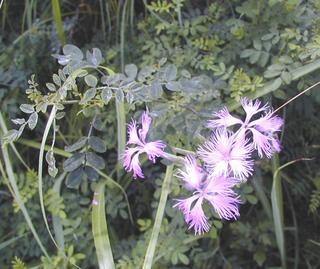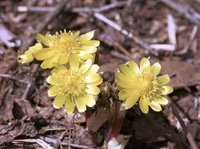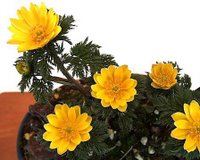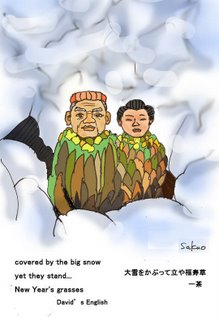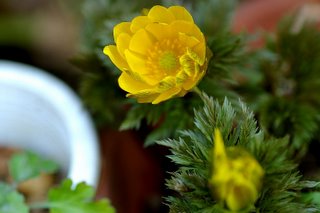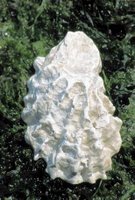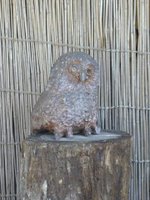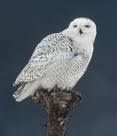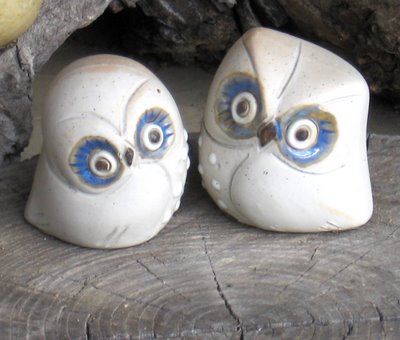:::::::::::::::::::::::::::::::::::::::::::::::::::::::::::::::::::::::::::::::::::::::::::::::::::::
Pilgrimage in Shikoku (henro)
***** Location: Japan
***** Season: Spring
***** Category: Observance
*****************************
Explanation
ZEN is well known in the West, but other forms of Japanese Buddhism are not.
To make the great pilgrimage around the island of Shikoku is not only reserved for believers of the Esoteric sects, but done by many people for many reasons, after retirement, after loosing a loved one or just for finding oneself as a youngster.
Many henro pilgrims carry a small haiku book and produce many beautiful haiku, some featured in the internet these days and some hidden in the pockets of the white robe, only shown to each other when meeting on the way.
The Shikoku Pilgrimage, henro 遍路, comprises many kigo for spring.
The cool climate of spring is the best time to walk the pilgims road in Shikoku.
But there are of course pilgrims all year round.
Pilgrm's Staff, the alter-ego of Kobo Daishi, henrotsue 遍路杖
Pilgrim's Hat, henrogasa, henro kasa, 遍路笠
the way a pilgrim walks, henromichi 遍路道
. Shikoku Henro 四国遍路 Pilgrimage to 88 Temples .
- Introduction -
. Stepping on the sacred sand of Shikoku
(sunafumi お砂踏み)
:::::::::::::::::::::::::::::::::::::::::::::::::::::::::::::::::::::::::::::::::::::::::::::::::::::
quote
Pilgrimages since the Meiji Period (1868-1912 AD) have basically preserved the patterns that emerged during the Edo Era. Nonetheless, most will admit that modern-day Japanese pilgrimages are incredibly commercialized. Many Japanese localities and prefectures, hoping to attract religious tourists, have copied the traditional pilgrimage patterns to establish their own modern circuits for the 33 Kannon and 88 Holy Sites in Shikoku. Today pilgrims travel in luxury by coach, minibus or taxi in prearranged tours. Nearly all modern pilgrims purchase the amulets, hats, satchels, staffs, bells, and other religious paraphernalia that are sold in abundance by temples, shrines, prefectural bodies, cities, and travel agencies. In many ways the modern pilgrimage in Japan is a thinly veiled disguise for tourism, stripped in large part of religious meaning.
And let us not forget. Since the Edo Period, Shinto and Buddhist practices among the common folk have been aimed primarily at this-worldly benefits (genze riyaku, concrete rewards now). To many Japanese, Shinto and Buddhist faith is primarily involved with petitions and prayers for business profits, the safety of the household, success on school entrance exams, painless child birth, and other concrete rewards now, in this life. This type of popular worship -- one focused on "this-worldly" rewards -- can easily fall prey to commercialism.
Learn more about Pilgrims stamps books and all the equipment
a pilgrim needs on the road.
RESOURCE GUIDE TO
JAPANESE PILGRIMS & PILGRIMAGES
also about
junrei 巡礼 pilgrimage to other temples
junrei 順礼 kanji used by Issa
:::::::::::::::::::::::::::::::::::::::::::::::::::::::::::::::::::::::::::::::::::::::::::::::::::::
Pilgrims at temple Nr. 55, Nankoo-Boo in Imabari, Shikoku.
Life is a pilgrimage!
A poster to promote the Shikoku Pilgrimage.
© Photo Gabi Greve
:::::::::::::::::::::::::::::::::::::::::::::::::::::::::::::::::::::::::::::::::::::::::::::::::::::
giving alms to henro pilgrims,
o-settai, settai 摂待
. Kado-cha 門茶 "tea at the gate" .
giving tea as alms at the temple gate
kigo for early autumn
 As the poor pilgrims walk along, they are supported by the local population, who see them as Kobo Daishi himself. They get a lot of food offerings, but also robes or money. Once I got a cotton towel to wipe the sweat. Even a ride in a car can be o-settai.
As the poor pilgrims walk along, they are supported by the local population, who see them as Kobo Daishi himself. They get a lot of food offerings, but also robes or money. Once I got a cotton towel to wipe the sweat. Even a ride in a car can be o-settai.Some villages have established a small stall with tables and seats at the village entrance, where the housewifes take turn in praparing tea and sweets for the tired pilgrims.
Other households provide free beds for one night, together with a small meal in the monring, some for many generations. They have become friends with the regular pilgrims, who take the tour many times in their lives.
At one place in front of a temple, an old woman was handing out mikan oranges, greeting each pilgrim with a smile, saying "Welcome to this temple, dear Kobo Daishi san!". For her, we were all the same re-incarnations of Kukai.
O-Settai is a way for the local people to "collect good points" to improve their karma in the next re-incarnation.
If you receive a gift of this kind, you have to hand over one of your pilgrim's prayer slips.

settai in form of a shoulder massage
- the beginning of settai -
. Emon Saburō 衛門三郎 Emon Saburo .
:::::::::::::::::::::::::::::::::::::::::::::::::::::::::::::::::::::::::::::::::::::::::::::::::::::
Shikoku Fudo Pilgrims to 36 temples
四国三十六不動尊霊場
My Pilgrims Guide
... group/Darumasan-Japan/message/424
... group/Darumasan-Japan/message/425
...group/Darumasan-Japan/426
Learn more about Pilgrims stamps books and all the equipment a pilgrim needs on the road.
... www.onmarkproductions.com/
Mark Schumacher
A pilgrimage to a Shinto shrine is called: Mairi
Three famous Shinto Pilgrimages
*****************************
Worldwide use
WKD : Earth Pilgrims アースピルグリム 。 地球巡礼者
Echan Deravy エハン・デラヴィ
.......................................................................
pilgrim
fascinated by a distance
of spaces
- Shared by Gennady Nov -
Haiku Culture Magazine, 2013
:::::::::::::::::::::::::::::::::::::::::::::::::::::::::::::::::::::::::::::::::::::::::::::::::::::
Croatia
Marija Bistrica: the Black Madonna with Child,
Our Lady of Bistrica, Queen of Croatia
The little town Marija Bistrica (literally Mary Bistrica) lies on the slopes of Mount Medvednica, about 15 km North-West of Zagreb. 16th century, about 5 ft., wood.
source : www.interfaithmary.ne
a pilgrimage -
new faces and new flowers
along the way
- Shared by Tomislav Maretic -
Haiku Culture Magazine , 2013
:::::::::::::::::::::::::::::::::::::::::::::::::::::::::::::::::::::::::::::::::::::::::::::::::::::
THE HAJ: PILGRIMAGE TO MECCA
One of a Muslim's duties, as described in the Five Pillars of Islam, is to go on Hajj at least once during his or her lifetime. This is a pilgrimage to Makkah (Mecca, Mekka) in Saudi Arabia. Approximately two million Muslims went in 1999, of which about one million were from Saudi Arabia, and 6,000 were from the U.S. Council on American-Islamic Relations estimated in 2006 that "some 10,000 American Muslims go on Hajj each year."
source : www.religioustolerance.org
her pilgrimage bag -
for the eleventh night
a pink neglige
Heike Gewi Yemen, July 2008
Kigo Hotline
.............................................................................
Joys of Japan, 2012
Mina and Arafah
pilgrimage exodus
heart and soul
- Shared by Mokhtar Sah Malik -
The towns of Mina and Arafah
source : www.hajtips.com/
haj -
with all my sins
I come to You
- Shared by Asni Amin -
:::::::::::::::::::::::::::::::::::::::::::::::::::::::::::::::::::::::::::::::::::::::::::::::::::::
INDIA
kamakhya on nilachal~
pilgrims trekking together
to mother's womb
This was written during a visit to Kamakhya Temple near Guwahati in Assam (North East India) recently. It is on a mountain named Nilachal (meaning Blue Mountain). The deity ie. Goddess Kamakhya is worshipped here in the 'yoni' form. It is a great Shakti peeth and a seat of Tantric cult of Hinduism.
Sunil Uniyal, India, August 2008
Kigo Hotline
More Reference about the Temple

*****************************
Things found on the way
*****************************
HAIKU
道の辺に阿波のへんろの墓あはれ
michinobe ni Awa no henro no haka aware
at the roadside
"The Grave of the Pilgrim from Awa" -
how touching
Takahama Kyoshi 高浜虚子
(written in 1935)
This grave is near Matsuyama at the temple hall Daishido 太子堂. On the memorial stone it says 阿波の遍路の墓 and Kyoshi only added the first and last part to this.
There are two stone steles to memorize this grave, slightly slanted, in the temple compound.
:::::::::::::::::::::::::::::::::::::::::::::::::::::::::::::::::::::::::::::::::::::::::::::::::::::
graves of the unknown -
pilgrims faces faded
into stone

Henro Pilgrims .. 遍路と無縁仏
Read some more of my Henro Haiku.
Shikoku Summer 2005
Gabi Greve
:::::::::::::::::::::::::::::::::::::::::::::::::::::::::::::::::::::::::::::::::::::::::::::::::::::
竹林 上り下りの 遍路道
takebayashi nobori kudari no henromichi
bamboo grove -
the pilgrim's path leads
up and down
Gabi Greve, Shiraishi Pilgrimage, June 2006
:::::::::::::::::::::::::::::::::::::::::::::::::::::::::::::::::::::::::::::::::::::::::::::::::::::
Early in his career, Santoka (1882-1940) was a henro.
autumn wind for all my walking . . . for all my walking . . .
"Where is the Way?" he was once asked.
"Under your feet," he replied.
Read a long article about pilgrims by Michael Hoffman .
:::::::::::::::::::::::::::::::::::::::::::::::::::::::::::::::::::::::::::::::::::::::::::::::::::::
暑さにも負けず遍路の道長き
atsusa ni mo makezu henro no michi nagaki
not even yielding
to the great heat ...
pilgrim on the road
Gabi Greve, July 2008, Fudo Pilgrimage Yamaguchi
*****************************
Related words
Pilgrimage to Shinto Shrines
***** Pilgrimage to Kyoto (Kyoo mairi 京参り )
Ise Shrine Pilgrimage, O-Ise-Mairi, Ise Mairi 伊勢参り
O-kage mairi お陰参り (おかげまいり)
Konpira Shrine Pilgrimage, Konpira Mairi 琴平参り
***** Grave (haka)
***** SAIJIKI of Japanese Ceremonies and Festivals
***** Henro Pilgrims Culture and Haiku
***** . Gankake 願掛け wish-prayer, to make a wish .
:::::::::::::::::::::::::::::::::::::::::::::::::::::::::::::::::::::::::::::::::::::::::::::::::::::
[ . BACK to WORLDKIGO . TOP . ]
[ . BACK to DARUMA MUSEUM TOP . ]
:::::::::::::::::::::::::::::::::::::::::::::::::::::::::::::::::::::::::::::::::::::::::::::::::::::
